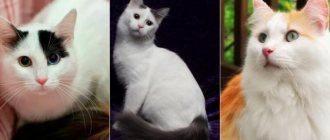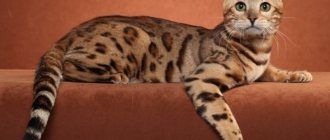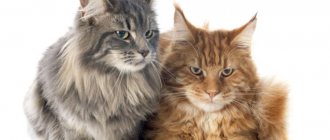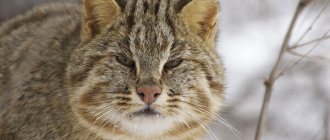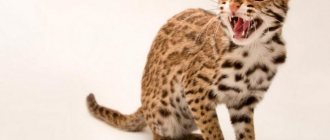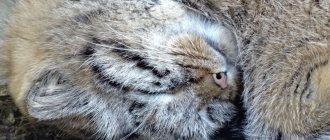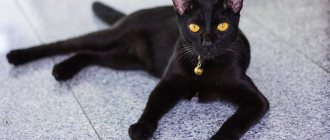History of the breed
The very first representatives of the breed appeared in 1981. Englishwoman Miranda Kirchberg had a lilac cat and a Persian cat with chinchilla hair. As a result of their mating, 4 kittens were born (all females) - graceful, big-eyed, with an aristocratic silver color. To consolidate the characteristic features, the grown-up fluffy beauties began to be mated with Burmese cats. By 1984, there were already three lines of offspring of the new breed. Burmillas received official recognition from the World Federation GCCF in 1986, and FIFe included them in the list of breeds in 1995.
The Burmilla breed was developed relatively recently - only in 1981
Basic colors
The Burmilla's coat comes in many color variations. Among them are:
- brindle (there are inclusions of blue or black)
- smoky (dark or chocolate shades)
- solid (black tortoiseshell, black British or cream)
- shaded (as if a dark-colored veil had been thrown over purple or brown fur)
Appearance of Burmilla
These animals are medium in size. Their bones are quite massive, so they are heavier than they appear: male cats weigh on average 4–5 kg, and male cats - from 3 to 3.5 kg.
The Burmilla's head has the shape of a shortened wedge with soft contours. The cheekbones are clearly defined and set quite wide. The chin and lower jaw are large. Vibris pads are clearly visible, but not massive. The eyes are large, oval and widely spaced. Their color should be green (bright or light shade). Cats' ears are wide at the base with slightly rounded tips. If you look at the Burmilla in profile, you will notice a slight tilt of the ears forward.
In kittens and young animals (up to two years old), yellow eyes are allowed, but in adult pets they can only be green.
The body of animals of this breed is slender and elongated with a massive and angular chest. According to standards, the back in an upright position should be straight from the shoulders to the croup; when the cat sits, a soft bend should form. The limbs are graceful with oval paws. The hind legs are slightly longer than the front legs.
The Burmilla has a slender and flexible body with a long, narrow tail.
Minor shortcomings that are not grounds for rejection, but reduce the price of a kitten, are:
- weak chin;
- plump cheeks;
- thickened tail;
- a slight arch in the back when the cat is upright.
Animals whose eyes are not green (in adults), whose muzzle is not wedge-shaped, whose paws are shortened or have excessive undercoat will be disqualified.
Video: Burmilla breed standards
Requirements for coat and color
Burmillas come in short-haired and long-haired varieties. Let's assume a small white undercoat. Their fur is soft and straight.
The standard color for the breed is color-point (acromelanic), when the hairs are ticked, that is, unevenly colored from light to dark, which creates a shimmering effect. Acceptable color point varieties for Burmilla are:
- caramel;
- blue (blue point);
- chocolate (chocolate point);
- lilac (lilac point).
The lightest parts of a cat's body are the chest, front legs and belly. The fur is darkest on the T-shaped area of the muzzle (forehead and nose), back, sides and front of the tail.
Photo gallery: Burmilla colors
A dark Burmilla baby is a rarity
One litter can have kittens of different colors
Silver color for Burmilla cats is classic
Lilac Point is a beautiful aristocratic Burmilla color
Tabby color (distinct stripes) cannot appear in kittens from purebred Burmillas.
One litter can have kittens of different colors
Standards
The Burmilla cat is a medium-built cat, elegant and graceful. Males rarely gain weight over 5 kg (7 kg is already a rarity), and even more so females: their weight is no more than 3.5. The bodies of the Burmilla are more stately than those of the Burmese, and more flexible than those of the Persians. Good physical shape, smartness and poise are characteristic of Burmilla, but fatty individuals suffering from shortness of breath and associated diseases are rare.
| Standard | Description |
| Head | Medium size, slightly flattened at the top. The muzzle is pointed and quite wide at the top (which gives the impression that the cat is smiling slyly). |
| Neck | Middle length. |
| Cheeks | They are rounded, and in cats they are noticeably larger and sometimes even sag with age. |
| Nose | Snub-nosed, small. |
| Eyes | Open and very expressive, almond-shaped, often outlined with a black border. They squint a little. The color of the iris is yellow in all shades, the entire palette is green (by the way, the color of the eyes is finally formed only in the second year of the animal’s life). |
| Ears | Small, with rounded tips, slightly tilted forward. Both outside and inside are pubescent. |
| Torso | Well developed. The skeleton is large, the muscular skeleton is compact. Massive chest area. The back is wide, but short. |
| Tail | Medium in thickness, long, smooth. The tip is pointed. Covered with thick hair. |
| Paws | Of medium length, widely spaced, the hind legs are always longer than the front ones. The paw pads are oval and soft. |
| Wool | The hairs are long and thin, and feel weightless to the touch. The undercoat is dense. There are both short-haired and long-haired Burmilla breeds. Cats with long hair resemble Persians in appearance: they have no undercoat, and the hairs on their body are soft and thin. The so-called “shirt front” grows in the neck area. The tail is also extremely fluffy. Most shorthaired Burmillas have tipping on their coat, and the coat itself is very pleasant to the touch. |
Indications for disqualification: too shaggy coat; stocky figure; Aquiline nose; different eye color.
Significant disadvantages: paws are too long or, on the contrary, short; short body; poorly developed chin; stripes on paws.
In the photo there is a cat of the Burmilla shorthair breed
Burmilla character
A cat of this breed is an excellent option for calm people who do not want their pet to endlessly run around the apartment, try to climb into every crevice, and jump on cabinets. Burmillas are very sociable, but at the same time quiet - they even meow rarely and quietly. They love to be hugged and petted. In the house they strive to be closer to the person - they sit next to the owners, willingly go on their knees.
Burmillas are very sociable cats and will always be close to their owners.
Burmillas are cautious cats. They will not immediately be drawn to a person, since their trust must be earned. They try to avoid strangers; when guests visit, they usually hide and do not come out of hiding until the strangers leave the house.
The favorite pastime of all Burmillas is to watch what their owners are doing in the room, or at passers-by and birds outside the window.
They treat children without aggression, but try to have less contact with them. Most likely, they will simply not notice the small family members and try to stay away from them. These cats have a similar attitude towards other animals. They will not be delighted if their beloved owners suddenly bring another cat or dog into the house, but they will not get involved in a fight for territory. Such a neighborhood will cause stress to the Burmilla, which may affect their health. Therefore, there is no need to add other animals to cats unnecessarily.
Related Burmillas growing together are very united, and they will be wary of animals brought from outside and are unlikely to accept them even after a long time.
Diseases
Although this breed is distinguished by excellent health and strong immunity, there are still a number of diseases that cripple these furry beauties.
Here are the most common ones in veterinary practice:
- polycystic kidney disease;
- allergic reactions;
- dry keratoconjunctivitis;
- orofacial pain syndrome.
To prevent the development of diseases in a four-legged family member, proper care and monitoring of the pet’s behavior is necessary.
If you have any suspicions, you should make an appointment with your veterinarian as soon as possible.
Health and life expectancy of Burmillas
Average life expectancy is 12–15 years. The weak point of the Burmilla is the kidneys. Many representatives of the breed have hereditary autosomal dominant polycystic disease, a disease in which multiple cysts form in the kidneys, causing the organs to cease to function normally. The cause is a mutation in the PKD-1 gene. Unfortunately, the pathology cannot be completely cured; you can only slow down the development of the disease or prevent exacerbations by correctly preparing the diet and providing the temperature conditions necessary for the cat. It is recommended to regularly take your cat’s urine to the clinic to determine the quality of kidney function.
Burmilla nutritional features
Due to their predisposition to kidney disease, Burmilla's require special nutrition. Make sure your cat is getting enough fluids, but not drinking too much. Excessive moisture puts a strain on the urinary system and can cause an exacerbation of hereditary pathology. It is better not to give too many soups or broths. The nutrient content of a daily dose of food should be approximately as follows:
- proteins - 12%;
- fats - 3.3%;
- minerals - 2%;
- fiber - 1.3%.
When choosing ready-made food, give preference to those whose packaging is marked “Helps maintain the health of the urinary system.” Make sure the food you choose contains vitamin D3, iron, iodine, copper, manganese, zinc and calcium. Suitable Burmillas are:
- RC Instinctive (in pate form);
- Prescription Diet Kidney Care (dry food);
- RC Indoor 27 (dry food);
- RC Urinary Cary (pieces of meat in sauce).
Burmillas need to be given special food that supports the functioning of their urinary system.
If a cat is diagnosed with hereditary polycystic disease in the chronic stage, then he will need phosphate binders (calcium carbonate or calcium citrate). They are found in renal foods, for example, Farmina Vet Life, Hill's Prescription Diet K/D Feline Renal Health, Purina Veterinary Diets NF, Eukanuba Renal. Weakened kidneys cannot properly remove phosphorus from the blood. This leads to the fact that the level of this substance in the body becomes too high, it begins to “take away” calcium, and the risk of osteoporosis increases. Sometimes there is a deficiency of sodium and magnesium, which can be compensated for with the help of vitamin supplements.
Conditions for keeping and caring for Burmilla
Burmillas do not require a large number of all kinds of mice and balls (1-2 toys are enough). Play areas with ladders, running wheels and other attractions leave these cats indifferent. They do not like to be alone and strive to be closer to their family. They will spend most of their time on or next to their owners' laps. What they will definitely like is a furnished place on the windowsill - Burmillas love to calmly watch what is happening outside the window.
Caring for Burmilla is not very difficult, but it has the following features:
- These cats shed heavily. Moreover, coat change occurs even with minor temperature fluctuations. Due to the soft texture of the villi, tangles quickly appear (even in short-haired cats). To prevent the formation of pellets and prevent fur from scattering throughout the apartment, it is recommended to comb the animal daily. You should not use combs with hard spikes; it is better to purchase brushes with natural bristles.
You can remove lost hair using a special mitten.
- Burmillas need to be bathed once every 2–3 months. Their fur is soft, and it is difficult for the animal to clean it with its tongue. Suitable washing products are Bio-Groom, Anju Beaute Cachemire Shampooing, Royal Groom. You can use tinted shampoos - mahogany Jerob Mahogony Gold Shampoo for brown color points or silver Jerob Parisian Purple Shampoo for blue and lilac colors.
- Ears should be examined once a week. Accumulations of sulfur are removed with a damp piece of cotton pad (not wet). It is recommended to use special lotions and drops that make it easier to care for cats' ears - Beaphar Oftal, All Systems Ear So Fresh, Iv San Bernard.
- Due to the large size of the eyes and soft fur that can get on the mucous membranes, Burmilla are prone to increased tear production. Once every 2-3 days you should wipe your eyes with a cotton pad soaked in tea leaves. You can use special zoo drops - Cliny, Ziver, Maxitrol, and Tsiprovet.
Feeding
A natural type of food is acceptable for cats of this breed. Salt is not added to cat food.
Table 2. Approximate Burmilla diet
| The product's name | Quantity | How many times a week |
| Beef (raw, deep frozen) | Kitten - 30 g, adult - 100 g | 7, the bulk of the diet |
| Chicken fillet, boiled | 100 g | 4 |
| Offal raw or after freezing | 2-3 | |
| Sea fish fillet (boiled) | Cats - 1, females - up to 2 | |
| Chicken egg yolk (can be with kefir or porridge) | 1-2 | |
| Low-fat fermented milk products | up to 7 | |
| Mild cheese | 1 | |
| Vegetables raw or pureed after cooking (cauliflower, green beans, carrots), alternate with grains | For 1 part vegetables 2 parts meat | 3-4 |
| Dry brewer's yeast | 3-4 | |
| Vegetable oil | ½ teaspoon | 3-4 |
The diet should contain vegetables, a source of vitamins and fiber.
We cook for pets ourselves
Ready diet
Many cat owners prefer ready-made products, since they already contain everything the pet’s body needs. In addition, manufacturers produce lines for cats with special needs. Such diets are designed for animals with allergies , sensitive digestive systems, stomach and intestinal diseases, etc.
The most famous products:
- super premium class: Fitmin For Life, Blitz, Leonardo;
- premium class: Brit Premium, Science Plan, Probalance;
- holistic: Acana, Grandorf, Go Natural.
Acana
Many of these lines contain products for both short-haired and long-haired breeds.
Attention! There should always be clean water next to the bowl. There are fountains on sale that enrich your drink with oxygen and keep you fresh for a long time.
Drinking bowl for cats
Breeding Burmilla
To preserve their characteristic characteristics, Burmillas are crossed with each other, as well as with Persian chinchillas and European Burmese. Mating with representatives of other breeds is not allowed, as the dominant traits will be lost.
Burmillas can be crossed with European Burmese - in 85% of cases, kittens are born that meet Burmillan standards
The optimal age for mating is 14–16 months. Mating cats at a younger age is not recommended, since if a cat becomes pregnant, it is highly likely that she will develop a deflection of the spine, and the birth will be difficult.
Burmillas can have 5–7 kittens in one litter
If the owners do not plan to breed cats, then it is better to castrate/sterilize the pet. The fact is that Burmillas are sexually active all year round; at any time a spree can begin, which will cause suffering to the animal and man. The operation is allowed to be performed upon reaching six months of age.
How to buy a kitten
In the CIS, this breed is quite rare, which is why Burmillas cost a lot. On average, you will have to pay $600–700 for one kitten. But this is the cost of breed and pet class - cats with minor defects. They are not suitable for participation in exhibitions; their offspring will be lower in price. Cats that closely match the breed (show class) cost 3–4 times more.
A three-month-old Burmilla kitten still has blue eyes - they will turn green with age.
It is better to purchase purebred kittens through nurseries. This will guarantee protection from scammers passing off cheaper kittens as Burmillas. The largest communities of Burmilla breeders in Russia are BURMILLIANT (Moscow), CHATBURDEOA (Serpukhov), LAMBERT (Moscow).
How much does it cost and where to buy a kitten?
In Russia, few nurseries are engaged in breeding the breed. The cat is rare, and its price starts at $1,500. In Europe it will be easier to buy a pet.
Burmilla kitten
It is currently impossible to purchase a purebred Burmilla from private breeders who do not have a nursery. When purchasing, the seller must present documents confirming the quality of the animal and its compliance with the breed.
Be sure to read:
Description of the Bombay Shorthair cat breed, surprisingly, but the name has nothing to do with India
What to pay attention to
When buying a pet, choose only an active kitten whose development corresponds to its age. The strong, healthy cub has no discharge from the eyes, ears or nose.
A well-developed kitten runs normally, without staggering. Any defects in its development should make you refuse to purchase.
Table: pros and cons of Burmillas
| Parameter | pros | Minuses |
| Attitude towards a person |
|
|
| Comfort of living in an apartment |
|
|
| Attitude towards other animals | They rarely show aggression. | They don’t make contact; they prefer to hide or simply ignore them. |
| Features of maintenance and care |
|
|
Cat health
Burmillas inherited polycystic disease from their Persian ancestors. The disease is rare and appears around the age of seven. With supportive treatment, it is possible to maintain the pet's health. In nurseries, animals are checked before mating and sick individuals are excluded from the breeding program. Therefore, the risk of buying a sick kitten is eliminated.
Cats have no other serious health problems. With proper care, a pet will live on average 15-18 years and will not cause problems for its owners.
The breed is characterized by early puberty, so castration or sterilization of the animal should be taken care of at 4-6 months. Typically, breeders sell neutered and vaccinated kittens. Early castration does not worsen health or affect physical development. Upon sale, you will be given a certificate, a veterinary passport and a bag of food that the kitten is used to.
To maintain health, revaccination and examination by a veterinarian should be carried out annually. They tolerate vaccinations and attention from strangers well, but do not like to be in a carrier for a long time.


